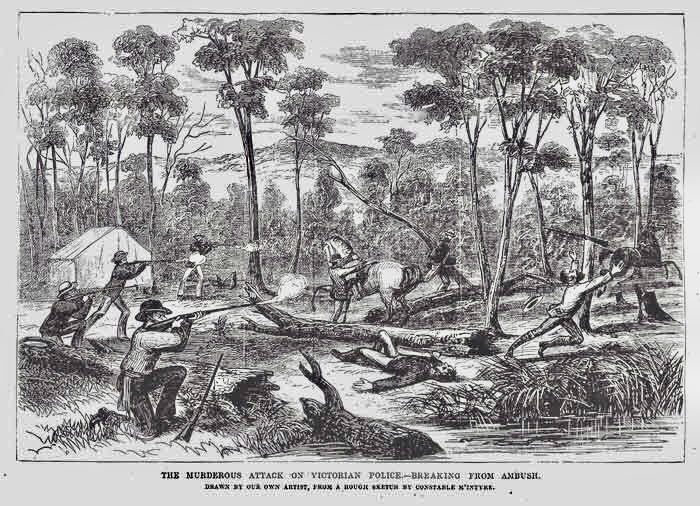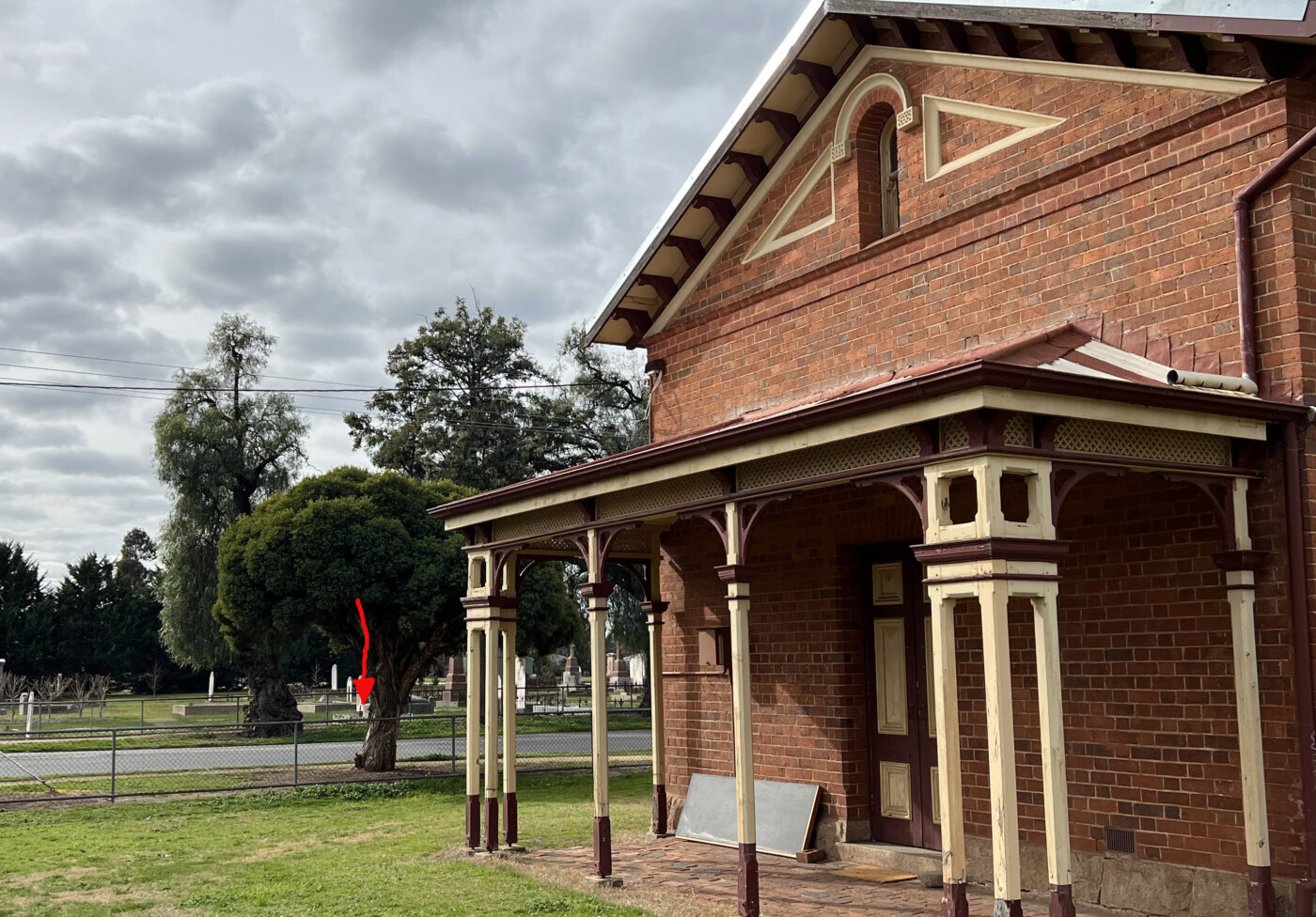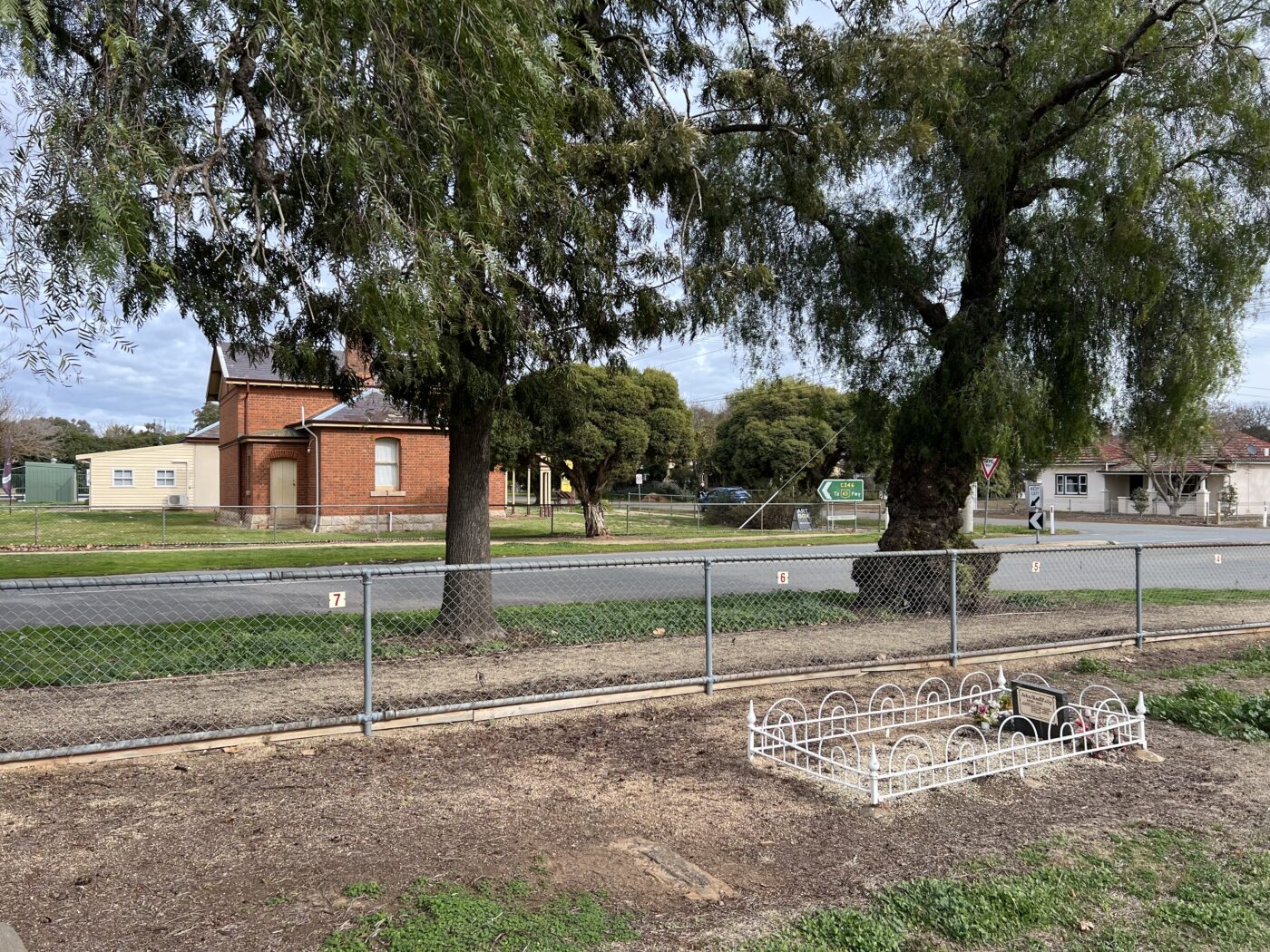This post is Part 4 of a review of Bill Denheld’s Ned Kelly – Australian Iron Icon: A Certain Truth (2024), by Stuart Dawson. As before, bracketed numbers, e.g., (xx), refers to pages in Bill’s book.
Bill disputes my description of Stringybark Creek as an ambush by defining ‘ambush’ as “a surprise attack by people lying in wait in a concealed position” (249). He argues that neither the initial encounter between the gang and officers McIntyre and Lonigan, nor the second encounter of the gang with Kennedy and Scanlan, were ambushes: the gang “staunchly walked into the camp [i.e., not lying in wait] and demanded that they raise their hands”; and when the other two returned to camp, “although the Kellys lay in wait, the returning police were warned [by McIntyre] to surrender. This later event was not an ambush” (250). This is splitting hairs. Another equally common definition is “a sudden attack made from a concealed position”,[1] which does not require lying concealed in wait and accurately describes the first advance of the Kelly gang from their concealed position behind a five foot tall stand of speargrass. In the subsequent second ambush the returning police thought McIntyre was jesting when, seemingly alone, he said they were surrounded. Both were armed attacks from concealed position, i.e., ambushes. No other word describes the events so clearly.
Bill returns to his narrow definition of ‘ambush’ several times, writing that “If Kelly had been able to convince the court that he and Dan and the others had no intention to ambush but rather they simply approached and walked into the strangers’ camp demanding them to bail up then perhaps Kelly’s conviction for the murder of Lonigan may have been reduced to self-defence or at worst, manslaughter” (292). He agrees with the McIntyre sketches that show that the gang first approached in a line from the south but ignores McIntyre’s repeated testimony that they advanced rapidly from concealment behind a belt of sword grass about 5 feet high (also shown in his detailed sketch). From Bill’s presentation one might think the gang simply wandered up in plain view, which is not correct.
Two pages later he again insists that McIntyre’s sketch “shows the four men entering the police camp from the south, all in a straight line side by side, rather than from different directions which could then be described as an ambush formation” (294). As above, the men’s alignment is irrelevant. Bill continues in regard to Burman photo 2, “In the first instance they did not sit and wait, as this would have been an ambush. They just walked into the camp and demanded that they bail up” (302). This all aims to support Bill’s view that Kelly “was put to death for an act of self-defence” (15). This won’t wash. The gang knew the four men were police troopers the day prior to the attack. In the second place, the gang’s attack on the returning troopers Kennedy and Scanlon for which they lay in wait in concealed positions perfectly reflects Bill’s preferred definition of ‘ambush’. Q.E.D.
As Redmond Barry J. summarised the situation at Kelly’s trial, “Regard them [the police in bush clothes] as civilians—he used the word because it had been made use of in the course of the trial, although he thought it inappropriate—what right had four other men armed to stop them? … These men were persons charged with a responsible and, as it turned out, a dangerous duty, and they were aware of that before they started. They went in pursuit of two persons who had been gazetted as persons against whom warrants were issued, and they were in the lawful discharge of their duty when in pursuit of these two persons; therefore they had a double protection — that of the ordinary citizen, and that of being ministers of the law, executive officers of the administration of the peace of the country. Whether they were in uniform or not, there was no privilege on the part of any person to molest them, and still less was there power or authority to molest them as constables”.[2]
Bill claims Burman’s Stringybark photo 1, which was produced in court, provided visual evidence that the Kellys were not the aggressors based on the orientation of the photo, which comes down to a longstanding argument between himself and the CSI@SBC group about the direction the photo was taken from. Accepting that Bill is right about the orientation, the photo is still just an approximate postcard reconstruction of the event showing where it happened, not a forensic re-enactment. Bill noted a committal hearing challenge that because McIntyre had not witnessed the death of Lonigan with his own eyes because was facing towards another direction, perhaps someone other than Ned Kelly had shot Lonigan dead (293). That challenge was nonsense: McIntyre’s testimony was that he was facing the four men; only Ned fired, and Lonigan died. What McIntyre didn’t see was the bullet hit Lonigan who was standing behind and to the left of him; but he did turn his head and see part of Lonigan’s fall. Bill further suggests that McIntyre’s Beechworth deposition “by all accounts varied from his first” (293). This too is not correct, as can be seen by reading all statements and the evidence given by McIntyre.
The idea that McIntyre’s statements were inconsistent was a furphy invented by Ian Jones in the 1967 Wangaratta Kelly seminar and maintained by him to the end. It has been massively influential but it is simply wrong. It depends on Jones taking Sadleir’s 1913 provably erroneous Recollections of the event and using that to assail McIntyre’s numerous statements which are highly consistent. It is wrong to accept Jones’ “by all accounts varied” claims as worth even the paper they are written on.
In any case as with the issue of shooting at and wounding Fitzpatrick discussed earlier, constables enjoyed a special protection under the law of that time (as Barry J reminded the Melbourne court), and in Lonigan’s case wilful murder was the only charge that could be prosecuted and argued.
Underpinning Bill’s narrative of Stringybark Creek is again a political suggestion. To Bill, the Kellys were harmlessly taking care of themselves: “While at Bullock Creek they did gold panning and sluicing, and grew sugar beet with a still for alcohol to sell as sly grog” (102). Meanwhile “The reason two police patrols were sent is more to do with the failure of government with a political bias in favour of the squattocracy and their land acquisition system. Their intention was to quell any possible ‘uprising among the settlers’ who were the most disadvantaged part of society throughout Victoria, but mainly in the North East” (104). Both of these claims are unsustainable. The reason two police patrols were sent was to continue the search for two alleged offenders wanted on charges of attempted murder and of aiding and abetting an attempted murder respectively, following a tip-off, not anything to do with government failure due to political bias. The October search parties were only two of many that were sent out,[3] with the SBC patrol ending in tragedy.
The Jonesian claim that selectors in Victoria generally were particular disadvantaged was rejected by Weston Bates in his response to Jones in Man & Myth (1968); and while Bates was willing to concede that a minority of people around Greta may have been so affected, Doug Morrissey’s 1987 Ph.D. analysis of selector fortunes demolished that theory as well. Woven into the narrative is the old chestnut that what triggered the gang to attack the police camp was “what looked like ‘undertaker body straps’ and packhorse equipment on the ground” (19). There is no reference for this because it is fiction. The Kelly gang never said any such thing, nor put any such accusation to McIntyre in his interrogation. It comes from Ian Jones claiming to have read something in “the Kinnear papers” that no-one else has ever seen, that some long straps in a 1930s stable were really straps souvenired from somewhere that had originally been body straps bought by the police from a Mansfield saddler for the SBC trip and thus proving the murderous intent of the search party! It is just conspiracy theory run riot.
As a side point, Bill disputes what Leo Kennedy wrote in Black Snake about the death of Sergeant Kennedy, saying that Leo “has a theory that Kennedy was standing upright when shot through the chest, but that is quite unlikely as Kennedy had time to write a small note to his wife while lying on the ground mortally wounded. Also … the gunshot to his chest had blown his backbone out”(213). What Leo wrote was in regard to one of Kelly’s statements, that Kelly “shot him in the armpit as he was behind the tree. Medical evidence would later show that the only way this could have occurred was if Sergeant Kennedy had his arms straight up in an act of surrender”, and it was at a later time that he was executed by the shotgun blast to the chest.[4] That time was after some hour and a half of interrogation as reported in G.W. Hall’s 1879 The Kelly Gang; or, Outlaws of the Wombat Ranges. Ned Kelly himself corroborated the event when addressing his prisoners at Younghusbands’ station before the Euroa robbery: “Ned Kelly said he was d—d sorry that Sergeant Kennedy was shot, he had no intention of shooting him if he had surrendered. Kennedy fired five shots at them as he was escaping, some of which grazed Kelly’s clothes, and one hit him in the sleeve of the coat. Kennedy was making for a tree, and was partly sheltered, when he was first hit in the arm. This caused him instinctively to move his arm up, and Kelly, thinking he was taking aim at him, shot him in the side, and he fell, for which he (Kelly) was very sorry”.[5]The lie is Kelly not admitting Kennedy’s surrender. There are no incongruities in Leo’s description of the events; it is consistent with all known facts. Further, it confirms that Kennedy did not reload when pursued; he had no time and no extra bullets.
Self-defence at Stringybark Creek?
Bill claims that “Gaunson worked hard to defend Ned’s murder charge on the grounds of self-defence” (19), referencing Alex Castles’ Ned Kelly’s Last Days. This is not correct: what Castles wrote is that when Gaunson took over from Zincke as Kelly’s solicitor at the Beechworth committal hearing he met with Kelly and it seemed “he was quite prepared to acknowledge his guilt in the Stringybark deaths, and he repeated what he had told Zincke in an interview earlier that week: that he was willing to face up to ‘all that he had done’. He argued that he had been entitled to attack the three police officers for what he claimed were ‘outrages’ that had been committed against himself and his family”.[6] Gaunson did NOT argue a self-defence case at Beechworth, nor at the Melbourne trial. The notion of self-defence as ‘shoot first’ comes only from Kellys’ ramblings in the Jerilderie letter.
Clearly Bill and I have different perspectives on the particular issues raised above, regardless that I find his extensive work on the location of the Stringybark Creek police camp persuasive, while claiming no expertise at all on it myself. My interest has always been in what happened, not where, and I don’t think the precise location itself is important in that regard.
The next part 5 of this review will take up the question raised by Bill as to whether the Kelly brothers were hunted for reward monies after the Fitzpatrick incident. Bill proposes that a share of reward money underpinned the eagerness of the police to catch them. I dispute this and argue that the police parties were not eligible for the post Fitzpatrick reward, which I will suggest was available to civilian informants only.
[1] “Noun: 1. A sudden attack made from a concealed position; 2. Those hiding in order to attack by surprise; 3. The hiding place used for such an attack”, American Heritage Dictionary of the English Language, 5th edn., https://ahdictionary.com/word/search.html?q=ambush; “the act of attacking unexpectedly from a concealed position”, Hamlyn/Macquarie Dictionary.
[2] Argus, 30 October 1880, 8, https://trove.nla.gov.au/newspaper/article/5977228
[3] Thomas McIntyre, A True Narrative of the Kelly Gang (PDF, Victoria Police Museum), 7.
[4] Leo Kennedy, Black Snake (Affirm Press, 2019), 108.
[5] Argus, 12 December 1878, 6.
[6] Alex Castles, Ned Kelly’s Last Days (Allan & Unwin, 2005), 152.

I was in Avenel yesterday and couldn’t help noticing that they buried Red where the coppers could keep a close eye on him from the Court House!
They didn’t mention that in The Ned Kelly Encyclopaedia!
Attachment
Not only that, but if he put his head up he’d get a hell of a fright. Not back there again, Noooooo!
Attachment
Interesting. You must live in the North East Stuart. Did you take Lola with you to Avenel? Speaking of which, serious question: why do they call him Lola?
The BBM Member and resident clown Steve Jager thinks that its funny to insult and mock someone by labelling them as a cross dresser. Lola is a character in a terrific Kinks number from 1970, way before its time. All the infantile thug Jager achieves by doing this is expose his own repulsive bigotry, his homophobia and his anti-LGBTQ prejudice. Mark Perrys BBM page is a refuge for legions of odious people like that – Perry himself is as sleazy as they come so no surprises he welcomes sad creeps like Jager and Fitzsimons and his new buddy Craig Barton into the fold. You would probably be at home there, because like the afore mention slezebags, your here to spread bile and scandal with nothing to say about the topic of this post. Typical of a brainless hypocritical sympathiser nut job.
Lighten up Francis. One of these men may save your life one of these days. Do you understand that?
You have nothing worthwhile to offer anyone here mate. Try sucking up to the Toad – he’s your type. And those ignorant bullies and thugs are not men. They are cretins.
Off topic I know but just been researching family involvement in Kelly outrage.
Stumbled across a beaut YouTube post entitled: Ned Kelly spoken by an eye-witness to Jerilderie robbery.
Well worth listening to the 90 year-old’s recollections.
The only way to fully understand the saga is to go back to original sources, bypassing all the crap that has been written over most of the past 100 years. And even then there are contradictions.
The Australian accent is wonderful.
Apologies if the posse has already listened to this.
Hi Don, that’s a great old film clip and I saw it a while back. It’s well worth a look for anyone who hasn’t seen it. Thanks for the reminder, and you’re right, recollections vary greatly in accuracy, especially when people insert themselves or their ancestors into the story. The YouTube link is here, https://www.youtube.com/watch?v=N5rFUnm_J3A&ab_channel=SteveJager